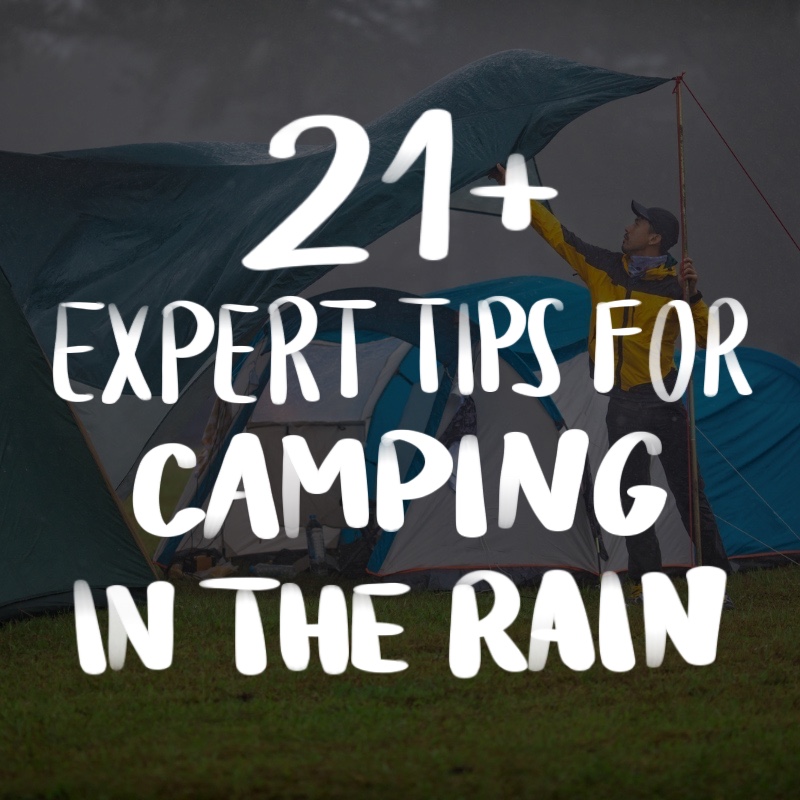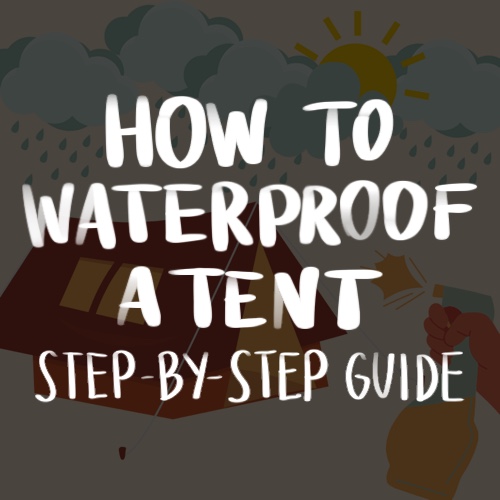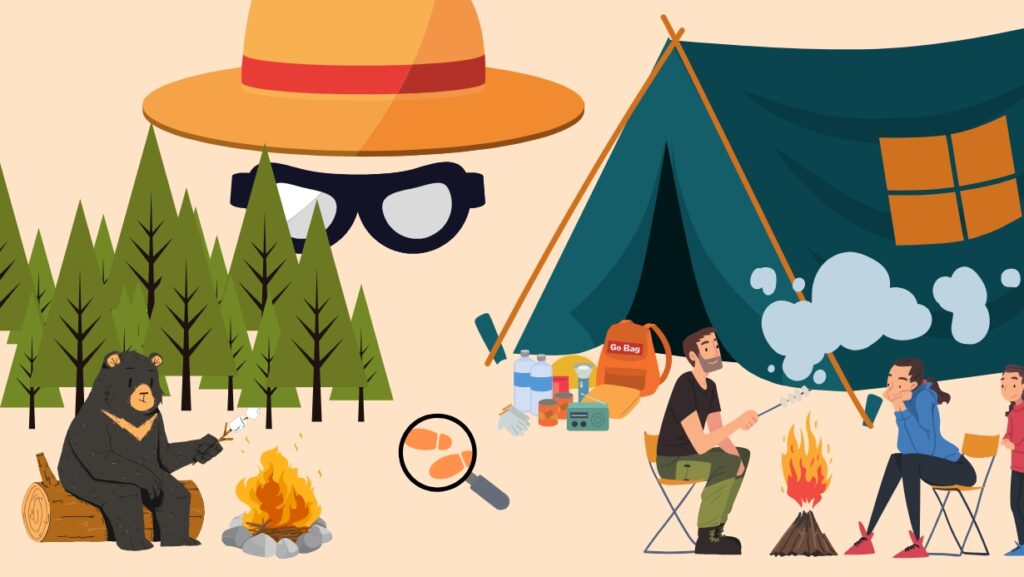
Have you already prepared the basics and need specific camping tips and tricks? Do you need to hear a few clever camping hacks to help you take your camping experience to the next level?
Camping is an activity that is always good and needed to continuously learn and gather insightful information and camping tips that can make your camping adventure unique or even save a life.
After I ended up in a tent too small, where gear, another person, and I couldn’t fit together (I will reflect on that right below), I haven’t slept at all; I started thinking twice before buying equipment.
We all know how exciting and rewarding camping can be, but it is also challenging, especially for those new to it. The good news is that with these simple hacks I prepared below, you can make your camping experience much more relaxing and enjoyable.
This blog post will share some of the best camping hacks I learned from my 10+ years of camping experience to help you get the most out of your next camping trip.
We’ve covered you, from clever gear hacks to tent camping and insect repellents.
Table of Contents
Tent and Sleeping Camping Hacks

Buy a Bigger Camping Tent Than You Need
Nobody loves a tiny tent, and camping in a tent isn’t easy, especially in the beginning.
I wish somebody had told me this camping hack before: when a tent is intended for two people, it means two people and nothing else. I didn’t know that back in time, so I had to use my backpack as a pillowcase and had gear on top of me. I recommend looking for a camping tent where you can fit one more person.
A bigger tent provides more interior space for comfort, storage, ease of movement, and increased headroom. It also allows more campers to sleep comfortably and provides extra space for gear or pets.
Additionally, a larger camping tent offers better ventilation and airflow, which can help reduce condensation and improve the overall camping in-a-tent experience.
Consider Buying a Double Sleeping Bag
One of many cool camping ideas is to buy a double sleeping bag. Any avid camper out there can confirm that.
If you’re going with someone you feel comfortable enough to share a sleeping bag with, don’t hesitate to do so.
A double sleeping bag will increase warmth since double sleeping bags provide more insulation compared to individual sleeping bags due to body heat share. Besides, it saves a lot of space and is easier to set up.
But if you need individual and double sleeping bags, depending on the situation, note that some individual camping bags can be coupled. You can have a sleeping bag or join your friend or partner.
Always Try Setting Up the Tent at Least Once Before Your Trip

Plenty of tents on the market can be set up differently, especially if they come from different manufacturers. It is why you’ll want to try and set it up in advance. You can do it even in your living room to test your skills and check if all the parts are there.
You don’t want to end up somewhere in the wilderness, realizing that there’s a screw missing or you’re unsure how to do something. This is why you should test gear such as a camp stove or tent before camping.
Speaking of setting up the gear, I’ve always wondered why it must be so hard to pack the tent and the sleeping bag back in their cases.
I wish you could practice this over time, but it can worsen. However, I’ll share a pro tip regarding the sleeping bag to make tent camping easier: bring any belt and use it to hold it back together.
Using an Old Yoga Mat as a Sleeping Pad
A yoga mat is another excellent floor solution. It’s more portable than the foam floor tiles since it can be suspended to your backpack if you’re hiking.
It’s very lightweight, made of similar foam material to the tiles mentioned above, and resistant. If they can endure excessive training and give soft support to joints, then it can surely endure one person just sleeping on it.
That said, it’s essential to remember that yoga mats aren’t explicitly designed for camping use as a regular sleeping pad and may not provide the same insulation and protection from the cold ground.
Cover the Tent Floor With Foam Floor Tiles To Make it Softer

Foam floor tiles are popular for camping as they provide a comfortable, cushioned surface for sleeping.
They insulate you from the cold and hard ground and are easy to install and remove. Its durability is long since this foam is a material that can withstand heavy use and resist damage from sharp objects.
The only thing you should look for is choosing the right size of tiles. It should match the tent size and the type of ground you’ll be camping on. Take extra care of its thickness and resistance to moisture, as these can impact its longevity.
Try to Keep Your Tent Zipper Closed and Your Sleeping Space Dry
Keeping your tent zipper closed at all times helps prevent insects and other unwanted pests from entering your tent while maintaining the temperature inside the tent and providing privacy and security.
It also highly reduces the possibility of the wind, rain, dust, or snow entering the tent. And this can ruin your camping experience.
Another brilliant idea: if your camping tent or sleeping bag gets wet in the end, empty it when you return home and hang it to dry before packing it on the shelf for your next trip. This way, your gear won’t grow moldy and will last longer.
Warm Your Cold Feet With a Hot Water Bottle During the Night
A hot water bottle will provide warmth and comfort during chilly nights. After you fill a bottle with hot water, make sure to insulate it. Wrap it in a soft material, such as a towel or a fleece blanket, to help retain heat and prevent the bottle from becoming too hot to the touch.
Placing it near your cold feet in your sleeping bag will help you stay warm and keep your lower body temperature.
When it gets cold at some point during the night, you can top it off with hot water from a pot or a camp stove. Or you can remove it altogether if you don’t need it anymore.
Keep your feet warm, but learn the safety precautions, such as not over-filling the bottle and insulating it properly to prevent burns.
Kitchen and Toilet Car Camping Hacks
Use Your Belt as a Tree Hanger For Drying Cookware
Some car camping hacks are multipurpose such as belts. Bring any belt to your next camping trip to waterless cookware and keep it above the ground. Here’s an easy way to do it:
- Find a sturdy branch or other structure to hang the belt from.
- Loop the belt around the branch and secure it in place.
- Use the buckle and loops of the belt to hang the cookware from it.
- Allow the cookware to air dry, which can take a few hours.
By hanging the cookware, you allow air to circulate freely and speed up the drying process. But most importantly, this helps prevent rust from forming and keeps your cookware clean.
Keep Your Cookware Rust-Free by Using Silica Gel Packs

Do you remember that little packets you keep finding packed together with different products you’re buying?
These are filled with granular silicic acid and used as a drying agent, and there’s a heavy reason they’ve made it to this camping hacks list.
It’s a non-toxic solution to keep your cookware free from rust forming if you don’t have the time to hang it and wait for it to dry correctly.
Place the silica gel packs at the bottom of each cookware before storing them. Remember to restore them periodically or when they stop absorbing moisture effectively.
The DIY Kitchen Made Out of a Shoe Organizer
Hang the shoe organizer on a tree branch or some other sturdy structure and fill the pockets with spices, cooking utensils, or food. Keeping food above ground is also a safe way to store it and keep it away from certain animals, such as bears.
A shoe organizer is a handy product that you can use for multiple purposes. Making your kitchen in the woods is just one of them.
You can also store personal items, first-aid kits, or camping gear. This way, things will stay organized and easily accessible while being well protected at the same time.
Take a Milk Jug to Camp as a Cooler For Your Next Camping Trip

No need to buy ice packs and carry them around, wondering whether they’ll melt when you reach the campsite. Keep necessary drinks and food cold at all times during your camping adventure.
Clean the milk jug well, remove the label, and fill it with water, leaving about an inch of space at the top. Freeze it a night before your trip to prepare it well for departure. You can also use a towel or blanket to insulate the jug and slow the melting process.
Using a milk jug (or a gallon jug) as a cooler filled with water, you can save space and weight in your camping gear and conveniently keep your food and drinks cold while on the trail.
Just be sure to dispose of the milk jug properly when finished, as minimizing your environmental impact is essential.
All the best camping hacks are closely connected to nature preservation, so keep the environment in mind.
Cook Scrambled Eggs From Milk or a Water Bottle
The camping hacks list has to include some meal planning.
Bringing eggs with you to camping can be quite a lottery. If you like eating eggs for breakfast, there’s a safe but unusual way to transport them.
Thoroughly prepare them before camping, from cracking them to adding spices (or storing spices separately). If you have one, place them into a milk bottle since it has a more significant bottleneck than the water bottle.
You will save time, dishes, and possible stress over cracked eggs in your backpack. Egg breakfast is indeed one of the most nutritious, and if there’s a way to have it on the campsite, I’d highly recommend it.
Store Toilet Paper Inside of a Plastic Container From Your Old CDs
Keeping toilet paper dry is essential for a comfortable camping trip. It fits in these plastic CD containers perfectly.
You can use any sealable container you might have, such as the ones where the food was once stored. That solution works very well if your toilet paper fits in any can.
It’s also important to note that you shouldn’t leave toilet paper behind. You should always do your best to follow the Leave No Trace principle to minimize damage to the natural surroundings.
Multipurpose Items You Need to Have While Camping
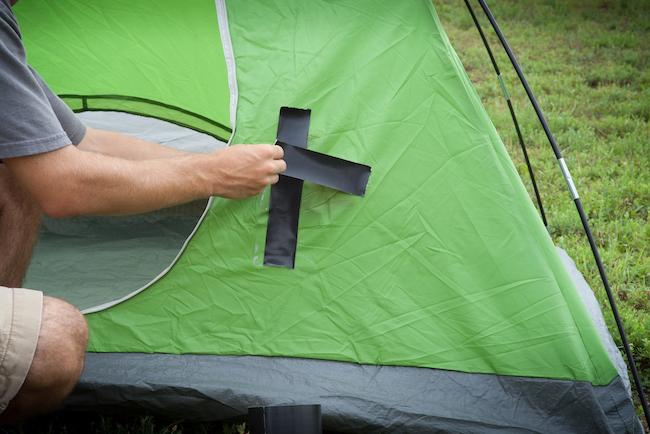
If You Do Need to Keep the Tent Open, Use Binder Clips
Let’s keep it simple: if you’re not by your tent and don’t constantly go in and out, you should keep it zipped. But you’ll need it open to vent the space, cook inside, or enjoy the view.
Binder clips come in handy and can be bought everywhere. You can also use them for other purposes, such as hanging your socks inside your tent to dry them.
But then again, it’s important to note that leaving the tent open for extended periods can expose you to the unwanted guests mentioned above. It’s best to keep the tent open only when necessary.
Inflate Your Air Mattress by Using Plastic Straws
Straws are a great camping tip idea since they can have several uses. One of them is for inflating air mattresses or other inflatable camping gear. This is especially useful if you don’t have or forget the air pump.
But not only that, you can use straws to clean small crevices in camping gear, such as water bottles or camping stoves. Insert the straw into the crevice and blow it to remove dirt or debris.
Blowing into straws will help keep the fire going, too. And on top of that, straws are great for DIY camping projects, such as making a tent or trap shelter or creating a fishing rod.
Believe it or not, these are just some of the many ways straws can be used for camping. It makes them a great choice to pack with you. By being resourceful and thinking creatively, you can find different situations in which these can be handy.
Solve or Prevent a Zipper Issue With Candle Wax

If you bring some candles to your camping trip, note that candle wax can be used as a zipper lubricant for camping gear, such as tents, sleeping bags, and clothing.
Melt the candle and let it burn until there’s a melted wax pool. Wait a bit to cool down, and apply it with your fingers or a brush.
You can use this technique if you have a current issue with tent zippers or to prevent it from getting in such a condition in the first place. Wax will keep your camping gear from damage if you maintain it regularly.
Pro tip: if you have left some birthday candles behind, don’t dispose of them but leave them for one of your camping trips.
Use Pool Noodles to Stop Tripping Over the Tent Pegs
Pool noodles in bright colors can help you pay more attention to that evil tent pegs. But not only that it will reduce the number of times you’ll stumble into it, but it will also make it far less painful if you do.
Besides, pool noodles are ridiculously lightweight, making them a perfect choice to carry around without adding much extra weight.
Cut the noodles to the desired length, slip them over the tent pegs, and secure them with tape or a rubber band.
Not only that, you’ll keep your camping trip more enjoyable this way, but also much safer. And you’ll avoid having a broken tent pole.
Store Your Dirty Shoes in Shower Caps
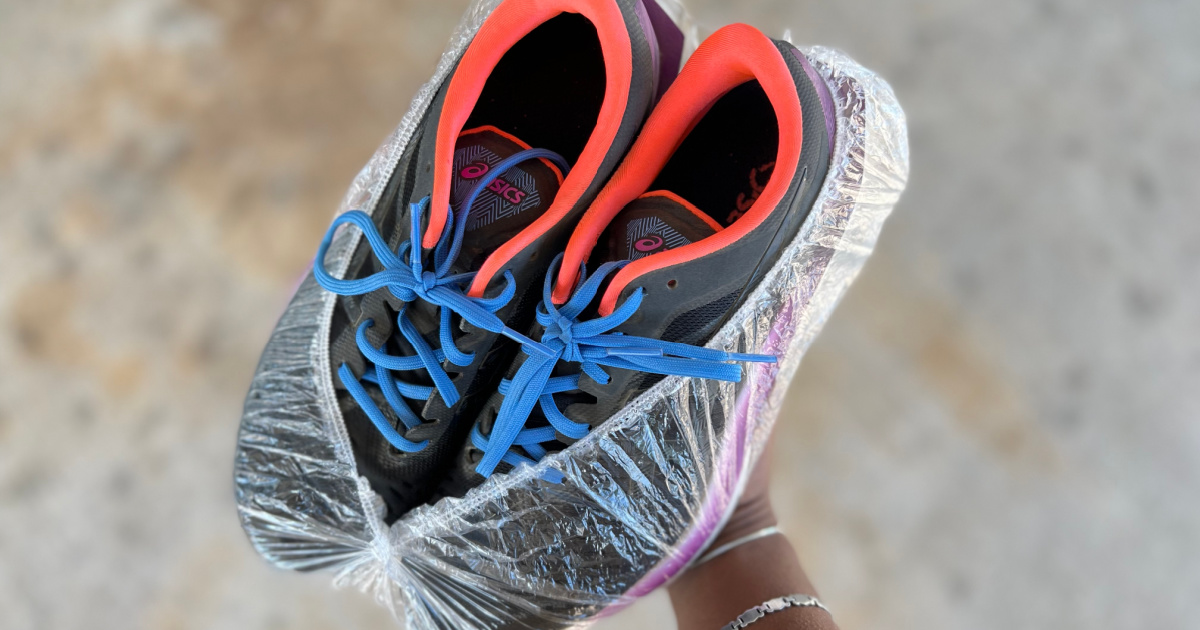
Camping tips that protect your tent from the outside dirt and moisture are essential. Shower caps are compact, cheap, and easy to pack, making them a convenient way to organize your shoes.
Apart from their utility, shower caps are reusable and more sustainable than disposable ones.
However, it’s important to note that shower caps are not high-quality and may not be suitable for larger or bulkier shoes. It’s recommended to consider the type of your footwear before using caps as storage.
Prepare Single-Use Soap Stripes by Cutting Them With a Vegetable Peeler
There is no need to carry a soap bar with you, which you probably won’t even consume by the end of your camping.
You can use a vegetable peeler instead to make small soap leaves. Pack it in a container or a bag, and keep it dry.
It is a superb hack for all backpackers who know how important it is to minimize the weight of their gear.
Marking Your Trail With Biodegradable Tape
If your camping includes hiking or just wandering around, it would be wise to ensure you won’t get lost out there in case your GPS battery dies. But you don’t want to leave garbage behind.
Biodegradable tape is designed to break down over time, reducing the environmental impact compared to non-biodegradable materials. And you’ll mark your way, so you don’t get lost. Everybody wins!
This tape is also made of non-toxic materials which are safe for wildlife. It s is both an animal-friendly and budget-friendly solution, much cheaper and safer than the paint or flags.
Of course, before deciding on the type of tape you’ll use, you should consider several factors, such as the expected weather conditions, the duration of your trip, and the type of trail you’ll be marking.
Garbage Bags are an Excellent Solution for Collecting Dirty Clothes
This is the most practical and cost-effective camping hack for managing laundry on the go. It’s incredible how functional a trash bag can be!
Garbage bags are lightweight and don’t take up much space, which makes them a convenient option for storing dirty clothes on camping trips. They can be easily stored in a backpack or carried separately.
Using this tip, you can keep the clothes contained and separate from your clean clothes and other gear. This helps to maintain both hygiene and organization. You will also reduce the risk of dirt and odors transferring to your clean clothes and equipment.
This simple yet genius camping idea will keep the odors away, and when you return home, you will have dry clothes that have already been adequately separated.
Campfire Camping Hacks

Use Batteries To Start a Fire
We’ve prepared some of the most efficient DIY fire starters.
Starting a campfire with batteries is possible using a technique called “Battery-to-Fire.” This technique is one of many fun camping ideas that involve using the electrical current from a battery to create heat and start a fire.
Here’s how to do it:
- Gather materials: You will need a 9-volt battery, a piece of steel wool, and some dry kindling or tinder.
- Prepare the steel wool: Unravel a small piece of steel wool and stretch it out to form a single strand. Touch both ends of the strand to the positive and negative terminals of the battery at the same time.
- Ignite the steel wool: The electrical current will heat it and cause it to burn. Use it while burning to ignite your dry kindling or tinder.
- Add larger logs once the fire has started.
This is also one of the survival camping hacks which should be used only in a safe and controlled environment. Never leave a fire unattended on your camping trips; always ensure to extinguish it properly before leaving the campsite.
Corn Chips and Doritos are Great Fire Kindles

If you end up in a survival situation on your camping trip, remember that corn chips and Doritos are made from highly flammable ingredients such as cornmeal and oil.
Using it for that purpose is relatively easy since you only have to add it to the existing fire pit and the foundation. Light the fire using a lighter or matches, and be amazed by how quickly you’ll get the flame.
Even though this is a survival method you should use if you don’t have access to traditional fire-starting materials, it works. It is the reason to use small quantities of chips, as they can quickly consume the oxygen in the fire pit and cause it to go out.
Dryer Lint Starts a Fire, too!
If you forget the original fire starter at home, there are many alternative ways to start a fire.
Dryer lint is a great choice since it’s highly flammable and can help get your campfire going quickly and efficiently while not taking up much space.
But you can use this hack if you have already collected it from your dryer’s lint trap after each load of laundry. If you decide to do it, store the lint in a plastic bag or container until you’re ready to go camping.
The only thing you should watch out for is that the dryer lint is clean and dry to ensure it ignites and burns well.
Cover Cotton Balls in Vaseline to Make a Fire Starter

Cotton covered in petroleum jelly (such as Vaseline) is one of the most efficient DIY fire starters since petroleum jelly is highly flammable.
Starting the fire with it is simple and looks like a traditional fire starter: place one or two of the petroleum-jelly-coated cotton balls in the fire pit and some dry tinder. Light it, and add larger pieces of wood to keep the fire going once it’s burning.
With these camping tips regarding campfires, you’ll start a fire quickly and easily, but it should be one of the survival methods. Because petroleum jelly is not a natural material and may impact greatly outdoors, it’s essential to use it wisely and only when necessary.
Let Bundles of Sage in the Campfire Save You From Mosquitoes

Bundles of sage act as a natural repellent due to the intense aroma of the sage plant.
Collect sage leaves, bundle them with twine or string, and add them to the campfire. The smoke will create a barrier that will keep the mosquitoes away. You can add more if you don’t notice it’s working immediately.
It’s good to remember that some people may be sensitive to the smoke from burning sage, so you should use it in a well-ventilated area and avoid breathing in the smoke directly.
Dry Your Shoes Properly
First, take the insoles out of the shoes and dry them separately. After that, you can use several methods to dry the shoes:
- Stuff the shoes with newspaper: The newspaper will help absorb moisture and speed up drying.
- Place near a heat source: If you have a campfire or a heater, you can use it to dry your shoes.
- Air dry: However, if you don’t have a heat source and the weather is sunny and dry, leave the shoes out in the open air.
- Camp dryer: This is the most expensive solution, but it’s still an option. Nowadays, you can find all kinds of stuff in the camping gear stores, such as portable camp dryers that can be used to dry wet shoes.
The ending tip: avoid leaving shoes near a heat source or open flames.
DIY Camping Hacks
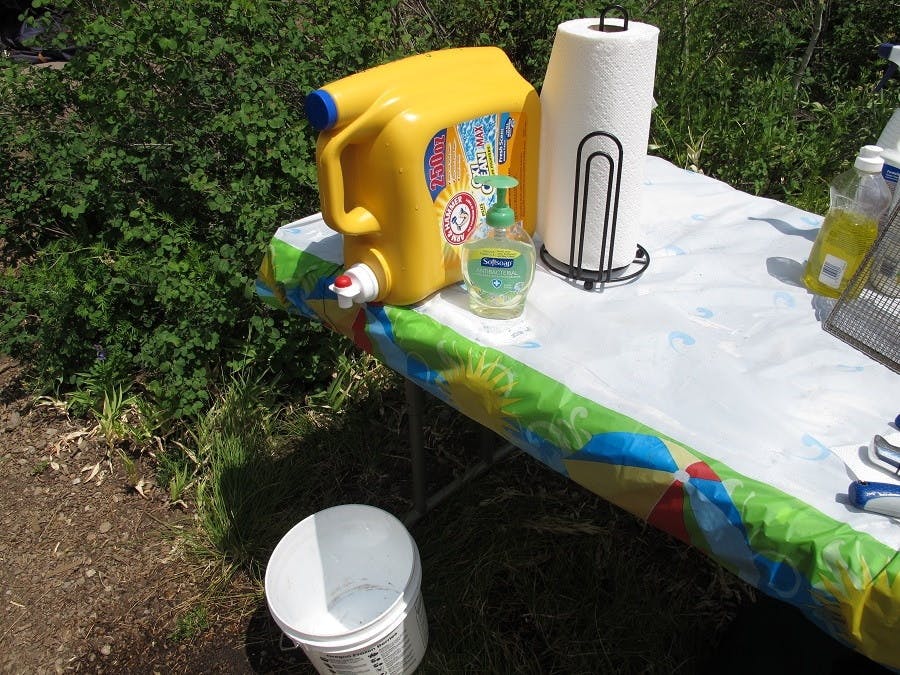
Make Your First-Aid Kit
This is maybe my favorite camping hack on this tips and tricks list.
If you gather first aid kit supplies by yourself, you will cover your specific needs.
Start by collecting essential items such as adhesive bandages, gauze pads, medical tape, scissors, tweezers, antiseptic wipes, pain relievers, and any personal medications you may need. You can store these in a durable container. A plastic box or resealable bag works well.
Complete your first aid kit with items unique to your needs or preferences.
Make a Lantern Out of a Water Bottle

What should you do if you need an additional light source and have forgotten a lantern at home? Don’t worry; you can make your lantern.
There are several ways to improvise a lantern on a campsite. Use a filled plastic water bottle and point a small flashlight or LED light at it. The light will shine through the water, and you’ll have an instant lantern.
If you have a flashlight, you can wrap it in a plastic bag for the same purpose. Candles or fires in a safe and contained area provide enough light for your campsite. Or use a headlamp by pointing it at a reflective surface, such as a tent wall of aluminum foil.
Swiss Army Tinker as an Ultimate Camping Tool
It is my top gadget for camping, together with duct tape. This multi-tool made by Victorinox, the original maker of the famous Swiss Army Knives, is great to have while camping. The compact and versatile little thing is shown to be very useful for camping and outdoor activities.
The Swiss Army Tinker is equipped with multiple tools, such as a blade, can opener, screwdriver, and scissors, making it handy for various tasks. It’s small and lightweight, making it easy to pack and carry around. It fits into a pocket easily and will last for a long time!
Even though it can’t always be used, especially for more demanding or heavy-duty tasks, it’s a great alternative to have with you, just in case.
Collect Herbs to Keep You Protected From Insects if You Forget the Bug Spray

Several herbs have insect-repelling properties and can be used as a natural alternative to chemical bug sprays. Here’s the list of the most effective ones:
- Citronella is one of the most well-known natural insect repellents commonly used in commercial bug sprays and candles.
- Lavender: Lavender has a pleasant aroma that can help keep insects away. You can crush the leaves or use lavender oil to improvise a bug spray.
- Rosemary: This herb is known for its miraculous repellent effect. You can burn dried rosemary leaves or also use its oil.
- Basil has a strong scent that can help deter insects, especially mosquitoes. As with lavender and rosemary, you can use its leaves or oil.
- Mint: Last but not least, peppermint, spearmint, and other mint varieties create a fresh, fantastic aroma that no insect can stand.
These herbs can be used fresh or dried, and their essential oils can also be used in various natural bug spray recipes. But, while some can be effective, they may not provide the same level of protection as commercial repellents.
So, try not to forget your spray at home!
FAQ
What are 5 camping safety tips you always need to follow?
You should always get all the possible information about the place you’re visiting; even acting paranoid about it wouldn’t be too much.
Campfire rules are no joke; one essential is keeping your tent at least 15 feet away from it.
Another four essential safety tips include:
1. Following the weather forecast a few days before a camping trip
2. Make sure to bring enough food and water
3. Taking care of the first aid package
4. Inform about the wildlife
What are camping hacks for camping with kids?
Every parent must know that great packing methods are necessary to bring children to such an adventure.
Speaking of which, there’s one excellent camping hack: when taking small kids camping, bring a bucket of adequate size to use as a bathtub.
Other camping tips and tricks include:
1. Use glow sticks or battery-operated lanterns for lighting at night, and pack extra batteries.
2. Pack a portable speaker for music and entertainment, and bring books and games to keep kids active during downtime.
3. Bring along a hammock for lounging.
4. Pack as much extra clothing as you can take with you.
What things make camping easier?
If you wonder what makes camping easier, these will reach the top of the list.
Consider your comfort if you’re going car camping. If you find that you do have some extra space, pack that picnic table and camp chairs.
Nowadays, compact and lightweight chairs aren’t that hard to find. Some even come with built-in cup holders and side pockets for added convenience.
You can also find a lovely, matching foldable table with multifunctional features such as coolers, grilling surfaces, or storage compartments.
When choosing the proper table and chairs, consider size, weight, and durability to find the best option for your camping needs.
How to make camping interesting?
Organize a scavenger hunt! It’s an exciting activity for the entire family to add to your camping adventure, whether with kids or adults.
Determine the theme and objective as if you’re playing a regular game. But set gathering a certain amount of wood as a primary goal. You can even figure out some clues and gather the necessary props, supplies, or needed for the task to be completed.
So, choose a safe area for this camping activity, and remember the Leave No Trace principle when explaining the rules. Ensure all participants understand the importance of staying on designated trails and respecting wildlife and the environment.
What do most people forget when camping?
Wood. It might sound funny, but people assume there will be enough on the campsite.
The list goes on: from sunscreen and bug spray to matches or a lighter for starting fires or lighting stoves. Some people even tend to leave the medical kit at home or other essential items such as proper clothing and footwear for the weather conditions, including rain gear and extra layers.
Making a comprehensive camping checklist before heading out is always a good idea to ensure you don’t forget anything important.
In conclusion, camping is an opportunity to escape the everyday life’s hustle and bustle, enjoy nature’s beauty, and have a fantastic time with your family and friends.
But it does require careful planning and preparation. Utilizing these camping hacks can elevate your camping trip; one of the following articles could be yours.
The camping hacks covered in this text provide practical solutions to many common challenges you may encounter while camping. No matter the level of your camping experience, this list is designed for you to make the most of your time out there.
Oh, and check out our camping tips; we’re confident you will find something valuable there, too!
So, grab your gear, grab a friend, or hit the trails alone – the great outdoors awaits you.
What do you think about this article? Feel free to write your thoughts, experience, and some fun stories in the comments. We would like to hear from you! Thank you
-
Aleksandar is a 29-year-old outdoor enthusiast with 10+ years of experience in camping and hiking. He found the Bored Adventurer because he loves spending his free time exploring the wilderness and sharing his experience with other fellow outdoor enthusiasts. Whether it’s the mountains or the seaside, summertime or winter, he jumps at every chance to escape the city and return to nature. His other interests include photography, digital marketing, and film.
View all posts


